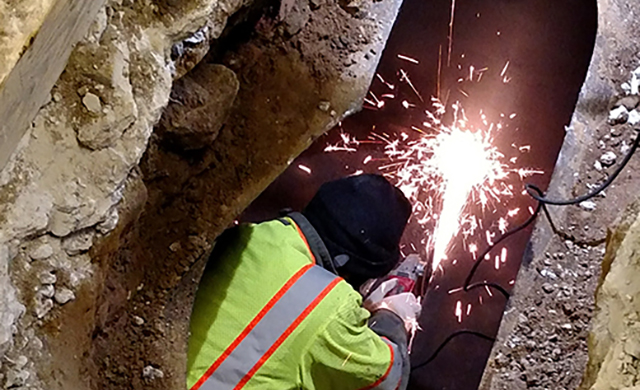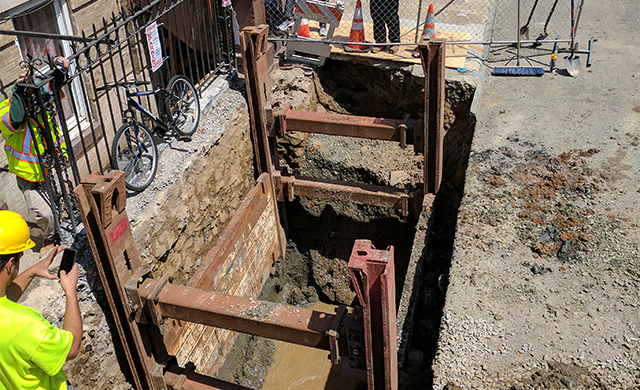PROJECT SUMMARY
ESA was retained by a property owner to remove a 3,000-gallon No. 2 fuel oil underground storage tank (UST) that formerly serviced a multistory residential building located in the historic district of Jersey City. The UST, which was decommissioned in 2013, was located beneath the sidewalk at the front of the building. Adding to the project complexity were structural concerns with the building, nearby utility conduits, and proximity of the street itself. Additionally, the work had to be conducted quickly to meet the closing deadline and needs of a prospective purchaser.
Because the tank was leaking, it could not be abandoned in place. And physical constraints prohibited ESA from using standard intact UST removal procedures. Instead, ESA cut and removed the UST in sections to limit site disturbance. As each tank section was extricated, petroleum-impacted soil was removed to the extent possible. Post-tank removal soil sampling confirmed the presence of residual soil contamination above New Jersey Department of Environmental Protection (NJDEP) Soil Remediation Standards (SRS). ESA then conducted a soil and groundwater investigation to delineate the petroleum-impacted media and found that these impacts were limited in depth and within the property boundaries in front of the building. These findings were used to evaluate a remedial method best suited for ESA’s client that would also satisfy the purchaser and their environmental consultants.
CHALLENGES
The buyer and the buyer’s lender each retained individual environmental consultants. Numerous joint meetings and conference calls between consultants extended the project’s duration, which needed to be completed as quickly as possible to preserve the sale. Additionally, structural concerns and limited work space created significant in-field challenges to effect remediation.
PROPOSED SOLUTION
Because of the property’s physical constraints, an in situ remedial method was identified as a potential solution and a work plan was developed for a dissolved oxygen in situ treatment approach. However, it was subsequently determined that this approach would not satisfy the buyer’s timeframe, and so it was abandoned in favor of a soil excavation technique that would enable ESA to remove pockets of impacted soil with precision while protecting the street and utilities as well as the building’s delicate concrete structures. To facilitate the process, it was necessary for ESA to install structural supports along the concrete stairs in front of the building and complete the digging in sections. Impacted soil extended into the saturated zone at twelve feet below ground surface (bgs), requiring use of a slide rail shoring system to permit digging while protecting the sensitive areas surrounding the impacted area.
OUTCOME
Remediation was completed ahead of schedule and below budget. Post-excavation soil sampling confirmed that sufficient impacted soil was removed to comply with NJDEP standards. As anticipated by ESA, dissolved contaminant concentrations in groundwater quickly attenuated following the removal of the impacted soil, thus obviating long-term groundwater sampling. Having demonstrated groundwater compliance, ESA then prepared final reports for site closure through the NJDEP Unregulated Heating Oil Tank (UHOT) program. The project took nine months from the day of UST removal to issuance of a No Further Action (NFA) letter. Through ESA’s efficient management of the project, the client met the buyer’s requirements and closed the sale on time.





